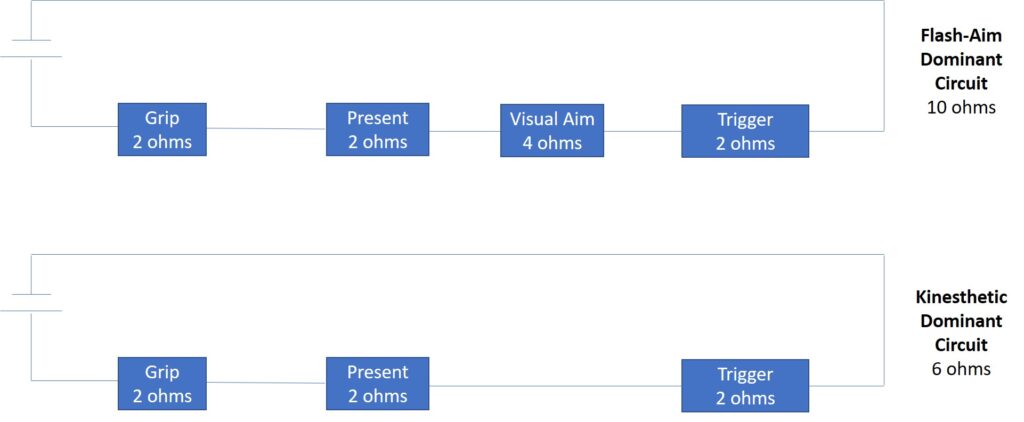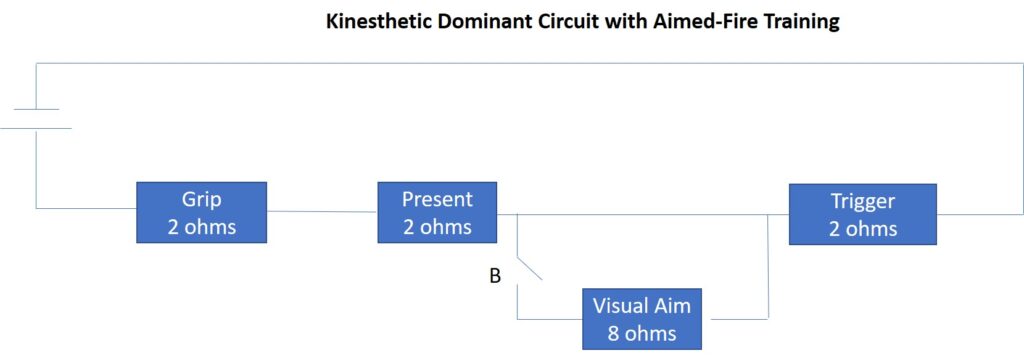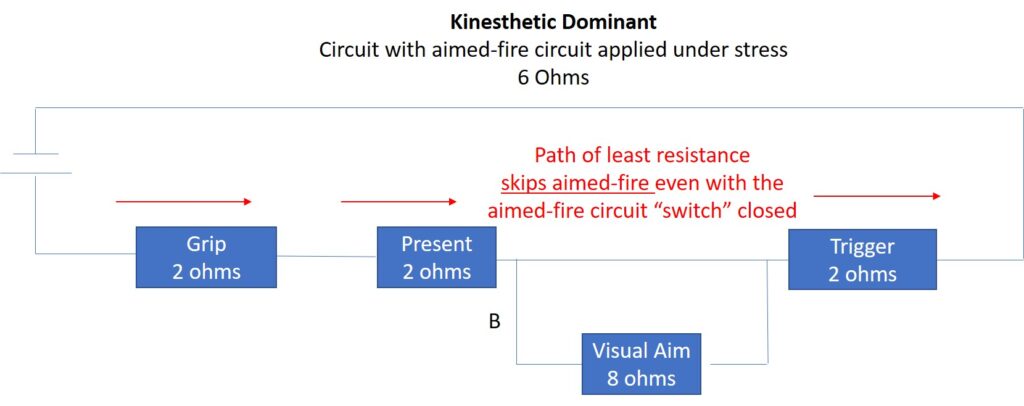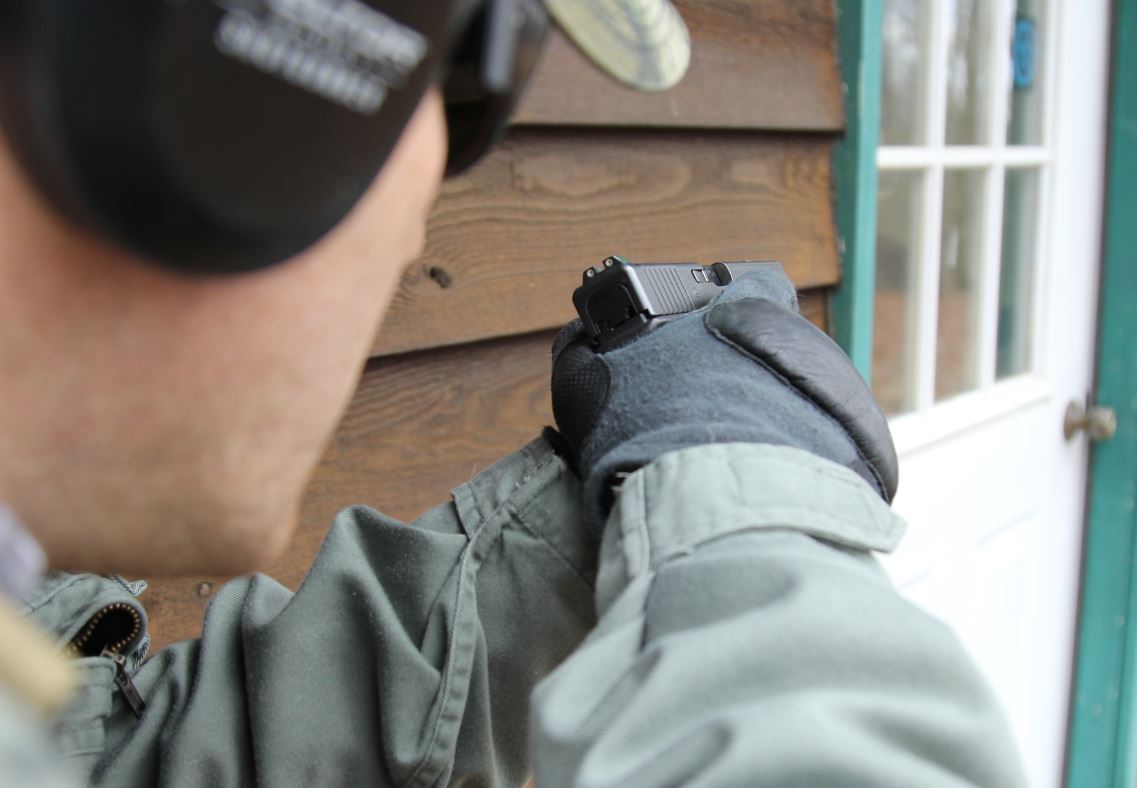In February of 2019 we wrote a LONG article about point, or kinesthetic, shooting and how it negatively impacts student performance when it is taught at the wrong time.
The intent of the first article was to synthesize all the relevant information and topics of discussion in one place. This is a long overdue follow-up that is intended to enhance and further explore one of the key points behind why instructors need to be careful when, and how, point shooting is introduced and practiced.
Before getting into it, it’s worth reiterating for the record that we are NOT criticizing point shooting as a technique, shooting discipline, or tactical tool. It is, in our opinion, a very important skill with critical real-world applications.
What we ARE doing is criticizing training methodologies that teach point shooting either (more or less) exclusively, or as the primary (dominant) engagement method.
Contrary to how some people have taken the first article, our criticism isn’t based around point shooting being ineffective or useless in the real world. It’s not useless or ineffective. It’s an important set of skills.
Rather, our criticism is based on the negative impact certain training methods have on student performance potential and the long-term—in most cases permanent—negative impact this can have on a student’s tactical capabilities.
Each person, regardless of his or her own personal opinion about the “real world” viability of kinesthetic shooting, must admit that visually aiming the weapon is eventually required to consistently hit the target.
Perhaps the most obvious performance-based example of this is Bill Roger’s Shooting School.
The majority of the rounds at Rogers are fired under 10ish yards at 8” plates (about the size of the ideal upper torso impact area for an average-sized person). No one legitimate would argue that this is a difficult shot to make from a marksmanship standpoint. Yet, in 40 years of the school operating, nobody has ever so much as qualified on the Rogers Test using point shooting techniques.
We could go on, but there’s no point, and you, hopefully, get the point.
While this may not be the case for hitting a full-sized silhouette at 5 feet, eventually every shooter needs to use a visual aiming system in order to hit the target. It just depends on the shooter and the target. (Yes, a few other things too.)
It is equally unarguable that there is a legitimate tactical requirement to perform this level of aimed-fire-required accuracy on the street—even for civilians. In the real world, whether this applies to any single individual at any given point in time is, well, subject to Mr. Murphy and his long history of “looking out” for those who fail to prepare.
Does this type of accuracy requirement exist in every shooting? No, of course not. However, it does exist in the real world. To assert otherwise is simply false.
What this means is that, unless you already know exactly what your students’ (or your own) eventual shooting(s) are going to look like and when and where they will happen (in which case you are clearly in the wrong profession), your students need BOTH combative-aimed-fire (as opposed to target-shooting-marksmanship) and kinesthetic shooting skills tucked away in the quiver in order to have a fully functional armed skillset.
This is doubly true for armed professionals.
For now, let’s agree to agree that this is true, even if just for the sake of continuing on with the discussion.
In the first article, we described two, polar-opposite aiming methods. We did this both for sake of simplicity and because it better suited our goals for the article.
The reality, as most readers know, is far more complex. There are a variety of different visual techniques and aiming methods out there, each with its own scale of performance.
Each one of these methods comprises its own unique method of skill performance. Each one also (keeping the discussion to what is admittedly very large handfuls) corresponds to its own neural circuitry in the brain.
Our use of the term “circuitry” here is important—because that’s what it is. The brain, at least mechanically speaking, is basically a vast array of biological electrical circuitry. And, just like any other electrical system, it is governed by the laws of physics.
Especially important, for our purposes here, is the commonly understood and accepted principal that electricity always follows the path of least resistance. (1)
When we train a well-learned skill, what we are really doing is creating a neurological circuit (or flow path for electricity) in the brain. The basic concept of neuroplasticity (brain change), also known as Hebb’s Law, is that neurons that fire together repetitively, eventually wire together—thus creating purpose-built neural circuitry.
In other words, when we conduct repetitive actions in training, physical changes occur in the brain and an actual, physical, electrical circuit is created.
Of course, as both shooters and instructors of shooters, this should be relatively intuitive and non-controversial. We can all see this play out in real-time through the development of our students, as well as the development of our own skills.
We have covered a lot already here, so let us briefly review before moving on.
- A functional combative skillset with firearms requires the ability to apply BOTH flash-aimed-fire AND kinesthetic-fire (point shooting)—as required to solve the tactical problem at hand.
- The brain is made up of electrical circuitry.
- The brain’s circuitry follows the laws of physics.
- Developing a well-trained skill means creating a purpose-driven electrical circuit in the brain.
Got it? Keep all of that in mind.
For the sake of simplicity in this article, please allow us to once again pretend that there are only two binary options with respect to “aiming” a firearm.
- “Flash-aimed-fire.” Sight picture and sight alignment are rapidly assumed. Both ocular and attentional focus are rapidly shifted to the physical sighting system that is attached to the weapon.
- Purely kinesthetic shooting. Ocular and attentional focus are completely driven to the intended target. In other words, “target focus” shooting. The shooter’s vestibular system is completely in charge of hitting the target.
If these are our two techniques, then we have the option to create the following two circuits in the brain.

Notice that, in the pictures, we are presenting each subcomponent of the skill (itself each a sub-circuit) as a measure of resistance within the complete skill circuit itself. For example, gripping the gun is shown as a two-ohm resistor and so-on. (For the internet snipers – please note that this is intended to be neither a technical shooting nor an electrical engineering guide.)
You may have also noticed that each circuit in the picture is labeled as “Dominant.”
What does this mean? It means that only one of these circuits (the dominant one—only one of them can actually have this status in the brain) is likely to be performed under stress.
Two questions should come to mind.
Which one will be dominant? And…
But I thought you said we needed both skills?
At face value, it’s easy to understand which technique will be dominant, assuming they are both trained and procedurally consolidated (stored in the long-term unconscious access memory system).
Electricity travels the path of least resistance. Therefore, the one with the least electrical resistance will be used—when under stress.
We can possibly bifurcate and use both of them with applied context. However, since we’re talking about applying deadly force with a firearm for both competing circuits, and you want to keep both circuits “active,” the contexts are probably going to overlap significantly. This makes separating them with context muddled and the potential for success limited, even in the best-case scenario.
In reality, what gets created during training is something more like a dominant circuit for shooting that has a “bypass” in it. If the other techniques are trained, access to them is governed by something similar to a switch.
This neural circuitry can be represented, at least conceptually, by one of the two diagrams below. In other words, the pictures below represent the two circuitry options that shooters (and trainers) have:


Notice above in the “Flash-Aim Circuit” that kinesthetic shooting equates, from a circuitry perspective, to shooting without the visual skill requirements of flash-aimed-fire. The shooter is just not doing those skills.
You may also have noticed that the “Visual Aim” subskill is rated in our concept drawings at 4-ohms in the dominant flash-aimed circuitry and at 8-ohms in the dominant kinesthetic circuit—within the flash-aimed-fire bypass.
Why is this?
Hebb’s Law in action.
Creating a dominant flash-aimed-fire circuit involves high repetition of flash-aimed-fire techniques during training. This “wires together” the flash-aimed-fire circuitry, both providing more insulation on the wires (myelin on axons) and improving connectivity at the synapses. This all makes the circuit stronger (less resistance), thereby making it easier for the signal to flow through it.
This means that (at least in our conceptual example), shooters who train for flash-aimed-fire as the dominant engagement technique expend about half the energy to visually aim as other shooters who train primarily to shoot kinesthetically do.
You’ll also notice that, in both circuits, there is a “bypass switch” located between presentation and trigger manipulation. (Once again please ignore minutia of technical shooting mechanics for the various techniques here—this is a conceptual example, simplified for purpose.)
This “switch” represents an option within the circuit.
During most low-stress training evolutions, closing this switch (and sending energy to the bypass) in both circuits isn’t too much of an issue once the bypass is built.
We can get electricity through the bypass in both circuits during low stress periods.
Why? Because we have the capability of applying great levels of “mental force” to our own brains.
In other words, we can actually physically control and change our brains through the application of thought. (2) This allows us to essentially think temporary alterations in the neural circuitry, and consciously send signals to places and through routes that they would not go on their own, without our conscious intervention.
Because our brains have this ability, under normal circumstances, when we are working under cognitive control, it’s not too much of an issue to use either aiming method (circuit)—on demand.
However, when under stress, things change significantly.
Stress triggers chemical releases in the brain that act as a “switch” to the unconscious memory system.
If you want to see the science behind this and learn more about the various information systems in the brain and how they apply to tactical training, we recommend our own 2016 book Building Shooters. Here we’ll keep it high level.
This unconscious system is far less governed by things like mental force (at least in the moment) and is more prone to producing automaticity of response. In other words, whatever circuitry is stored in this specific memory system is probably going to get used more or less “As Is” when the chips are down.
This is why teaching (or practicing) kinesthetic shooting so that it becomes the dominant response is so dreadfully harmful to students’ potential.
Remember how electricity follows the path of least resistance?
Look at the diagrams below to see what happens when we “close the switch” to engage the respective bypass in each of the two possible “aiming” circuit options.


If a shooter’s dominant circuitry is based on flash-aimed-fire, shooting kinesthetically involves using LESS energy than the dominant circuit does.
This means that, even though the dominant engagement method is flash-aimed-fire, kinesthetic shooting can still be applied, even from the unconscious memory system.
Once the bypass circuit is activated, (3) it now becomes the path of least resistance. (4)
On the other hand, if the dominant neural circuitry is based on kinesthetic shooting, the shooter cannot apply aimed fire under stress.
In this case, the “bypass” resistance value is much higher than that of the dominant circuit.
Therefore, it is virtually impossible for electrical signals to make it through the flash-aimed-fire circuitry during unconscious (under stress) performance.
This isn’t because point shooting is wrong or bad. (It’s not.) It is simply because—physics.
Point shooting and combative-aimed-fire are both important components of functional armed skillsets, so let’s stop fighting about them.
Good tactics is not about dogma. It’s about applying the right techniques and methods at the right times, on the right terrain, for the right reasons, to accomplish an objective.
May we suggest that this extends to training techniques and methods as well.
By all means teach point shooting. In fact, in our opinion, you should be teaching it.
But let’s not hurt students in the process—damaging their long-term performance potential and negatively impacting their survivability through poor training design.
Build a dominant circuit of combative-aimed-fire first. Then, introduce appropriate kinesthetic shooting techniques—applied for the right reasons, in the right settings—and build a purpose-built kinesthetic bypass into the dominant flash-aimed-fire circuitry.
Footnotes
(1) We at Building Shooters make every effort to be as accurate as possible in our writing. Therefore, let us add a disclaimer and acknowledge that the human brain is incredibly complex and, even now, not terribly well understood by even the most advanced levels of neuroscience.
Even what is thought to be currently known about the actual processes that govern the material discussed in this article involves subjects like quantum mechanics and highly complex chemistry. We won’t discuss these things here partially because they are far out of our depth (and likely yours as well), but also because the actual mechanics involved aren’t particularly relevant to the point of the article.
Consider the dropped glass example. Calculating the full forces, mechanics, and final outcome of dropping a drinking glass on a concrete floor—down to the final location, size, and shape of every glass shard—would be so complex as to be virtually impossible to calculate, even with super computers. However, one certainly doesn’t need a PhD in mechanical engineering and a bank of super computers to understand (or predict accurately) that a glass will, in fact, shatter if it is dropped on a concrete floor.
It’s the same concept at work here. Modern science has observed enough about the brain to have reached a thus-far unchallenged consensus that it adheres to the laws of energy conservation.
Therefore, while this article is admittedly not “accurate” in a mechanical, scientifically academic way, the concepts are nevertheless true to the best of our current understanding and are strongly supported at a systems level by current scientific understandings and models of neurological function.
(2) Sounds spooky right? We highly recommend The Mind and the Brain: Neuroplasticity and the Power of Mental Force by Jeffrey M. Schwartz MD, and Sharon Begley as a starting point if this subject matter interests you.
(3) Integrating context or specific stimuli into training as a method to “flip the switch” and activate the bypass circuitry could potentially take the form of a decision in response to stimuli, a failure of the primary/dominant technique to work (such as a failure to stop event), or a trained response that is associated during training to specific stimuli.
(4) For any dogmatic point shooting haters out there, please note that you still must build the circuitry before you can apply the bypass to access and apply kinesthetic shooting skills under stress. This means you still need to learn kinesthetic shooting if you want a complete, functional combative skillset.
Steering clear here of specific technique and method discussions, it is a fact that kinesthetic shooting is a skill (well, actually a set of skills). This means that it can be (and, in our view, should be) trained, practiced, and improved on—like any other shooting skill. If you assume you can point shoot effectively in a fight simply because you are good at flash-sight-fire, you may well be wrong. Worth thinking about…

